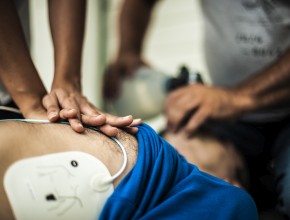Theme of the week: new therapies with important effects, difficult names, and very high prices.
Secukinumab in ankylosing spondylitis
Secukinumab, an interleukin-17A inhibitor, markedly improves quality of life and functioning of people with ankylosing spondylitis.
Over 300 patients with active ankylosing spondylitis not controlled on high-dose nonsteroidal anti-inflammatory drugs participated in a trial receiving placebo or one of two doses of secukinumab. Over the course of one year, monthly injections of the drug were associated with improvements on several quality of life measures, on average exceeding the minimal important difference, and thus likely providing a major benefit for many patients. No clear information on untoward effects was presented, and there were no obvious differences in the efficacy between the higher and lower doses of drug (150 mg vs 75 mg every 4 weeks). The annual potential per-person cost of the drug in the US exceeds $20 000 for a 150 mg dose.
Inclisiran for lowering LDL levels
One or two injections of a medication may dramatically decrease the low-density lipoprotein (LDL) cholesterol level.
In this preliminary dose-finding and safety study, serine protease proprotein convertase subtilisin-kexin type 9 (PCSK9) given as one or two injections decreased the LDL cholesterol level by up to around 50%. This study is not ready for clinical application but following the story of this medication will likely be of interest. The cost is not yet clear.
Evolocumab in patients with CV disease
Dullaart RP. PCSK9 Inhibition to Reduce Cardiovascular Events. N Engl J Med. 2017 Mar 17. doi: 10.1056/NEJMe1703138. [Epub ahead of print] PubMed PMID: 28304233.
Schulman KA, Balu S, Reed SD. Specialty Pharmaceuticals for Hyperlipidemia--Impact on Insurance Premiums. N Engl J Med. 2015 Oct 22;373(17):1591-3. doi: 10.1056/NEJMp1509863. Epub 2015 Oct 7. PubMed PMID: 26444460.
Everett BM, Smith RJ, Hiatt WR. Reducing LDL with PCSK9 Inhibitors—The Clinical Benefit of Lipid Drugs. N Engl J Med. 2015 Oct 22;373(17):1588-91. doi: 10.1056/NEJMp1508120. Epub 2015 Oct 7. PubMed PMID: 26444323.
Evolocumab decreased the low-density lipoprotein (LDL) cholesterol levels by 60% and lowered the risk of stroke (absolute reduction of 0.4%) and myocardial infraction (absolute reduction of 1.2%).
This study included over 27 000 patients with atherosclerotic cardiovascular disease (myocardial infarction, nonhemorrhagic stroke, or symptomatic peripheral vascular disease, plus additional risk factors) who were receiving statins and had an LDL cholesterol level of at least 1.8 mmol/L. Evolocumab, a monoclonal antibody inhibiting proprotein convertase subtilisin-kexin type 9 (PCSK9), was given in subcutaneous injections, either 140 mg every 2 weeks or 420 mg once a month. By 48 weeks, active treatments decreased the LDL level from an average of 2.4 mmol/L to 0.8 mmol/L. After a median follow-up of over 2 years, the risk of myocardial infarction was reduced from 4.6% to 3.4% and the risk of stroke – from 1.9% to 1.5%. There were no differences in mortality and no major safety concerns. The potential annual per-person cost of the drug in the US exceeds $15 000.
In a series of accompanying papers, the authors discussed the new situation created by the availability of effective medications coming at increasingly higher costs, translating into several hundred thousand dollars for one avoided event. The financial consequences of using such therapies in a large number of patients are being explored.
 English
English
 Español
Español
 українська
українська




